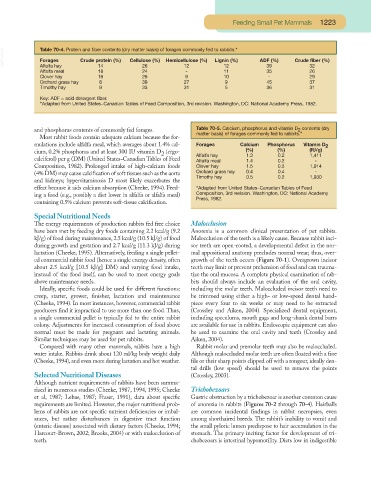Page 1173 - Small Animal Clinical Nutrition 5th Edition
P. 1173
Feeding Small Pet Mammals 1223
VetBooks.ir Table 70-4. Protein and fiber contents (dry matter basis) of forages commonly fed to rabbits.* ADF (%) Crude fiber (%)
Cellulose (%)
Hemicellulose (%)
Crude protein (%)
Lignin (%)
Forages
Alfalfa hay
-
18
24
Alfalfa meal 14 26 12 12 39 32
26
11
35
Clover hay 16 26 9 10 - 29
Orchard grass hay 8 39 27 9 45 37
Timothy hay 9 33 31 5 36 31
Key: ADF = acid detergent fiber.
*Adapted from United States−Canadian Tables of Feed Composition, 3rd revision. Washington, DC: National Academy Press, 1982.
and phosphorus contents of commonly fed forages. Table 70-5. Calcium, phosphorus and vitamin D contents (dry
2
matter basis) of forages commonly fed to rabbits.*
Most rabbit foods contain adequate calcium because the for-
mulations include alfalfa meal, which averages about 1.4% cal- Forages Calcium Phosphorus Vitamin D 2
cium, 0.2% phosphorus and at least 300 IU vitamin D (ergo- Alfalfa hay (%) (%) (IU/g)
2
0.2
1,411
1.3
calciferol) per g (DM) (United States−Canadian Tables of Feed Alfalfa meal 1.4 0.2 -
Composition, 1982). Prolonged intake of high-calcium foods Clover hay 1.5 0.3 1,914
(4% DM) may cause calcification of soft tissues such as the aorta Orchard grass hay 0.4 0.4 -
Timothy hay 0.5 0.2 1,930
and kidneys; hypervitaminosis D most likely exacerbates the
effect because it aids calcium absorption (Cheeke, 1994). Feed- *Adapted from United States−Canadian Tables of Feed
ing a food (e.g., possibly a diet lower in alfalfa or alfalfa meal) Composition, 3rd revision. Washington, DC: National Academy
Press, 1982.
containing 0.5% calcium prevents soft-tissue calcification.
Special Nutritional Needs
The energy requirements of production rabbits fed free choice Malocclusion
have been met by feeding dry foods containing 2.2 kcal/g (9.2 Anorexia is a common clinical presentation of pet rabbits.
kJ/g) of food during maintenance, 2.5 kcal/g (10.5 kJ/g) of food Malocclusion of the teeth is a likely cause. Because rabbit inci-
during growth and gestation and 2.7 kcal/g (11.3 kJ/g) during sor teeth are open-rooted, a developmental defect in the nor-
lactation (Cheeke, 1995). Alternatively, feeding a single pellet- mal appositional anatomy precludes normal wear; thus, over-
ed commercial rabbit food (hence a single energy density, often growth of the teeth occurs (Figure 70-1). Overgrown incisor
about 2.5 kcal/g [10.5 kJ/g] DM) and varying food intake, teeth may limit or prevent prehension of food and can trauma-
instead of the food itself, can be used to meet energy goals tize the oral mucosa. A complete physical examination of rab-
above maintenance needs. bits should always include an evaluation of the oral cavity,
Ideally, specific foods could be used for different functions: including the molar teeth. Maloccluded incisor teeth need to
creep, starter, grower, finisher, lactation and maintenance be trimmed using either a high- or low-speed dental hand-
(Cheeke, 1994). In most instances, however, commercial rabbit piece every four to six weeks or may need to be extracted
producers find it impractical to use more than one food. Thus, (Crossley and Aiken, 2004). Specialized dental equipment,
a single commercial pellet is typically fed to the entire rabbit including speculums, mouth gags and long-shank dental burrs
colony. Adjustments for increased consumption of food above are available for use in rabbits. Endoscopic equipment can also
normal must be made for pregnant and lactating animals. be used to examine the oral cavity and teeth (Crossley and
Similar techniques may be used for pet rabbits. Aiken, 2004).
Compared with many other mammals, rabbits have a high Rabbit molar and premolar teeth may also be maloccluded.
water intake. Rabbits drink about 120 ml/kg body weight daily Although maloccluded molar teeth are often floated with a fine
(Cheeke, 1994), and even more during lactation and hot weather. file or their sharp points clipped off with a rongeur, ideally den-
tal drills (low speed) should be used to remove the points
Selected Nutritional Diseases (Crossley, 2003).
Although nutrient requirements of rabbits have been summa-
rized in numerous studies (Cheeke, 1987, 1994, 1995; Cheeke Trichobezoars
et al, 1987; Lebas, 1987; Fraser, 1991), data about specific Gastric obstruction by a trichobezoar is another common cause
requirements are limited. However, the major nutritional prob- of anorexia in rabbits (Figures 70-2 through 70-4). Hairballs
lems of rabbits are not specific nutrient deficiencies or imbal- are common incidental findings in rabbit necropsies, even
ances, but rather disturbances in digestive tract function among shorthaired breeds. The rabbit’s inability to vomit and
(enteric disease) associated with dietary factors (Cheeke, 1994; the small pyloric lumen predispose to hair accumulation in the
Harcourt-Brown, 2002; Brooks, 2004) or with malocclusion of stomach. The primary inciting factor for development of tri-
teeth. chobezoars is intestinal hypomotility. Diets low in indigestible

